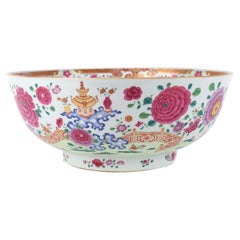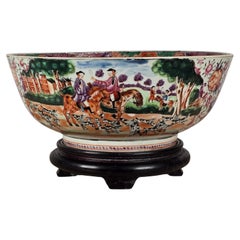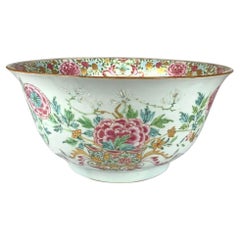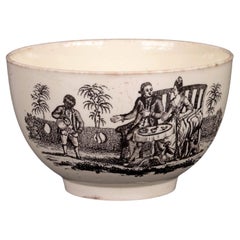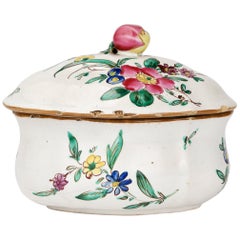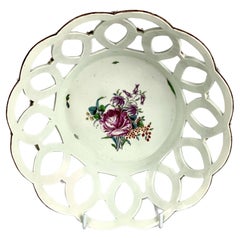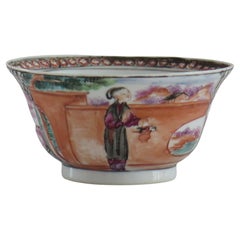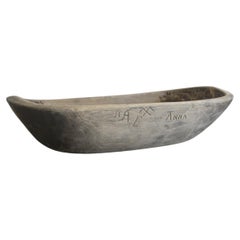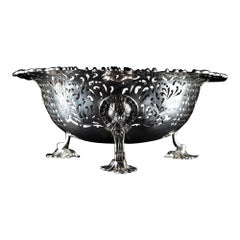1770s Bowls and Baskets
to
20
923
2,079
11,494
3,438
1,630
5,890
2,316
257
105
346
410
248
1,124
1,513
983
347
133
4
3
2
16
9
7
4
3
14
6
16
11
10
3
3
Height
to
Width
to
20
20
20
2
1
1
1
1
Period: 1770s
Chinese Export Porcelain Large Famille Rose Punch Bowl
Located in Downingtown, PA
Chinese Export Porcelain Large Famille Rose Punch Bowl,
Circa 1765-75
A large Chinese export porcelain punch bowl, distinguished by its vibrant famille rose enamel decoration. The e...
Category
Chinese Chinese Export Antique 1770s Bowls and Baskets
Materials
Porcelain
A Famille Rose 'hunt scene' Punch Bowl Qianlong Period
Located in Kilmarnock, VA
A superb Chinese Export porcelain 'famille-rose' hunt motif punch bowl. Qing Dynasty, Qianlong period(1735-1795) painted with two large landscape cartouches with Hunting scenes, the...
Category
Chinese Chinese Export Antique 1770s Bowls and Baskets
Materials
Porcelain
Large Antique Chinese Export Porcelain Bowl Famille Rose Hand Painted C-1770
Located in Katonah, NY
This exquisite 18th-century Chinese export porcelain bowl was hand-painted during the Qianlong era, circa 1770, using colored enamels in the Famille Rose palette.
Pink peonies in ful...
Category
Chinese Chinese Export Antique 1770s Bowls and Baskets
Materials
Porcelain
Wedgwood Attributed Bat Printed Creamware Teabowl
By Wedgwood
Located in Bishop's Stortford, Hertfordshire
A very fine antique English creamware teabowl bat printed with scenes to two sides and attributed to Wedgwood and dating from around 1770. The teabowl is lightly potted standing raised on a narrow round foot rim with a simple raised round bowl shaped body. The teabowl is decorated to sides with black printed designs, one portraying a resting seated shepherd within a landscape with his dog and sheep...
Category
English Georgian Antique 1770s Bowls and Baskets
Materials
Creamware
Italian Maiolica Ancient Sugar Bowl, Lodi, 1770-1780
Located in Milano, IT
Maiolica sugar bowl
Antonio Ferretti Manufacture
Lodi, Circa 1770-1780
Maiolica polychrome decorated “a piccolo fuoco” (third fire).
It measures 3.54 x 4.52 x 3.54 in (9 x 11,5 x 9 cm)
Weight: 0.394 lb (0.179 kg)
State of conservation: small and slight chips on the edges.
The small sugar bowl has a swollen and ribbed body resting on a flat base. The cap-shaped lid follows the rib of the container and is topped with a small knob in the shape of a two-colored fruit.
The sugar bowl is painted “a piccolo fuoco” (third fire) with the characteristic floral motif of bunches and isolated semis.
An example which closely corresponds to this one is kept at the Civic Museum in Lodi (G. Gregorietti, Maioliche di Lodi, Milano e Pavia, Catalogo della Mostra, Milano, 1964 n. 137).
This decorative style represented a strong point of the Lodi factory, which established itself thanks to the vivid nature of the colors made possible by the introduction of a new technique perfected by Paul Hannong in Strasbourg and later introduced by Antonio Ferretti to Italy. The production process, called “piccolo fuoco” (third fire), allowed the use of a greater number of colors than in the past; in particular, the purple of Cassius, a red made from gold chloride, was introduced. Its use allowed for many more tones and shades, from pink to purple.
The Ferretti family started their maiolica manufacturing business in Lodi in 1725.
The forefather Simpliciano started the business by purchasing an ancient furnace in 1725 and, indeed, we have evidence of the full activity of the furnaces starting from April of the same year (Novasconi-Ferrari-Corvi, 1964, p. 26 n. 4). Simpliciano started a production of excellence also thanks to the ownership of clay quarries in Stradella, not far from Pavia. The production was so successful that in 1726 a decree of the Turin Chamber came to prohibit the importation of foreign ceramics, especially from Lodi, to protect internal production (G. Lise, La ceramica a Lodi, Lodi 1981, p. 59).
In its initial stages, the manufacture produced maolicas painted with the “a gran fuoco” (double fire) technique, often in turquoise monochrome, with ornamentation derived from compositional modules in vogue in Rouen in France. This was also thanks to the collaboration of painters like Giorgio Giacinto Rossetti, who placed his name on the best specimens next to the initials of the factory.
In 1748 Simpliciano made his will (Gelmini, 1995, p. 30) appointing his son Giuseppe Antonio (known as Antonio) as universal heir. After 1750, when Simpliciano passed away, Antonio was directly involved in the maiolica factory, increasing its fortunes and achieving a reputation on a European level. Particularly important was the aforementioned introduction in 1760 of the innovative “a piccolo fuoco” (third fire) processing, which, expanding the ornamental repertoire with Saxon-inspired floral themes, was able to commercially compete with the German porcelains that had one of its most renowned offerings in the naturalistic Deutsche Blumen. Antonio Ferretti understood and promoted this technique and this decoration, proposing it in a fresher and more corrective version, less linked to botanical tables, both with or without contour lines, as well as in purple or green monochrome. After efforts to introduce more industrial production techniques to the sector succeeded, even the Ferretti manufacture, in the last decade of the eighteenth century, started heading towards decline despite its attempts to adapt production to neoclassical tastes.
In 1796 the Napoleonic battle for the conquest of the Lodi bridge over the Adda definitively compromised the furnaces. Production resumed, albeit in a rather stunted manner, until Antonio's death on 29 December 1810. (M. L. Gelmini, pp. 28-30, 38, 43 sgg., 130-136 (for Simpliciano); pp. 31 sgg., 45-47, 142-192 (for Antonio).
Bibliography
G. Gregorietti, Maioliche di Lodi Milano e Pavia Catalogo della Mostra, Milano, 1964 n. 137;
C. Baroni, Storia delle ceramiche nel Lodigiano, in Archivio storico per la città e i comuni del circondario e della diocesi di Lodi, XXXIV (1915), pp. 118, 124, 142; XXXV (1916), pp. 5-8;
C. Baroni, La maiolica antica di Lodi, in Archivio storico lombardo, LVIII (1931), pp. 453-455;
L. Ciboldi, La maiolica lodigiana, in Archivio storico lodigiano, LXXX (1953), pp. 25 sgg.;
S. Levy, Maioliche settecentesche lombarde e venete, Milano 1962, pp. 17 sgg.;
A. Novasconi - S. Ferrari - S. Corvi, La ceramica lodigiana, Lodi 1964, ad Indicem; Maioliche di Lodi, Milano e Pavia (catal.), Milano 1964, p. 17;
O. Ferrari - G. Scavizzi, Maioliche italiane del Seicento e del Settecento, Milano 1965, pp. 26 sgg.;
G. C. Sciolla, Lodi. Museo civico, Bologna 1977, pp. 69-85 passim; G. Lise, La ceramica a Lodi, Lodi 1981;
M. Vitali, in Storia dell'arte ceramica...
Category
Italian Rococo Antique 1770s Bowls and Baskets
Materials
Maiolica
Antique Worcester Porcelain Basket Dr. Wall First Period Circa 1770 England
Located in Katonah, NY
This 18th-century Worcester Porcelain chestnut basket is beautifully decorated with hand-painted polychrome enamels.
The interior features a stunning spray of hand-painted flowers, ...
Category
English Antique 1770s Bowls and Baskets
Materials
Porcelain
Worcester Chestnut Basket, Cover and Stand, Polychrome Flowers, 1770-1775
Located in London, GB
This is a very rare offer of a spectacular moulded and pierced chestnut basket, cover and stand, made by Worcester between 1770 and 1775 in their 1st or "Dr Wall" period. The set con...
Category
English Rococo Antique 1770s Bowls and Baskets
Materials
Porcelain
Blue and White Delft Dishes Antique Pair Made circa 1770
Located in Katonah, NY
We are pleased to offer this pair of blue and white Dutch Delft dishes with lovely chinoiserie decoration, which features an image of a vase overflowing with flowers.
Around the vas...
Category
Dutch Chinoiserie Antique 1770s Bowls and Baskets
Materials
Delft
Sèvres White Glazed and Gilt Porcelain Écuelle, Cover and Underplate, circa 1775
Located in New York, NY
Puce and yellow painted marks, Lacking date mark, painters' marks Charles Buteux, gilder’s mark for Jean Chauvaux.
Category
Antique 1770s Bowls and Baskets
Materials
Porcelain
Two Pairs of Italian Maiolica Baskets, circa 1780
Located in Milano, IT
Two pairs of maiolica baskets
Antonio Ferretti Manufacture
Lodi, circa 1770-1790
Maiolica polychrome decorated “a piccolo fuoco” (third fire).
Measures: A) Height 3.54 x 6.69 x 9.84 in (9 x 17 x 25 cm);
B) Height 3.93 x 7.48 x 11.02 in (10 x 19 x 28 cm).
Total weight 4.85 lb (2.200 kg)
State of conservation:
A) One of the smaller baskets has some areas of restoration, the other slight chipping from use;
B) One of the larger baskets is intact and the other shows a clearly glued break.
The mold with which the baskets were forged simulates a wicker weave.
The two larger works have high, vertical walls, with branch-shaped handles penetrating the weave. The painted decorations, small polychrome flowers applied only externally, highlight the points where the weaves intersect.
The decision to leave the center of the basket devoid of decoration is highly unusual, but given the size and complexity of the shape, as well as the quality of the enamel, it is possible to hypothesize that it represents a precise choice in manufacturing or for a particular client.
The two smaller baskets have small, twisted handles and, on the outside, reproduce more decisively the characteristic wicker weave, obtained through thin molded lines. The interior exhibits a rich, typical decoration of naturalistic flowers: a bunch centered around a main flower and secondary stems accompanied by small “semis”. The exterior of these works is also adorned with small little flowers where the weaves intersect.
The size and morphological characteristics of the baskets confirm their attribution to the Lodi factory of Antonio Ferretti between 1770 and 1790, during its most successful period; by this point his original reworking of the "Strasbourg" decoration, known as "old Lodi", had achieved great fame even outside Italy.
This decorative choice represented a strong point of the Lodi factory, which established itself thanks to the vivid nature of the colors made possible by the introduction of a new technique perfected by Paul Hannong in Strasbourg and which Antonio Ferretti introduced in Italy. This production process, called “piccolo fuoco” (third fire), allowed the use of a greater number of colors than in the past; in particular, the purple of Cassius, a red made from gold chloride, was introduced. Its use allowed for many more tones and shades, from pink to purple.
The Ferretti family had started their maiolica manufacturing business in Lodi in 1725.
The forefather Simpliciano had started the business by purchasing an ancient furnace in 1725 and, indeed, we have evidence of the full activity of the furnaces from April of the same year (Novasconi-Ferrari-Corvi, 1964, p. 26 n. 4). Simpliciano had started a production of excellence also thanks to the ownership of clay quarries in Stradella, not far from Pavia. The production was so successful that in 1726 a decree of the Turin Chamber came to prohibit the importation of foreign ceramics, especially from Lodi, to protect internal production (G. Lise, La ceramica a Lodi, Lodi 1981, p. 59).
In its initial stages, the manufacture produced maolicas painted with the “a gran fuoco” (double fire) technique, often in turquoise monochrome, with ornamentation derived from compositional modules in vogue in Rouen in France. This was also thanks to the collaboration of painters like Giorgio Giacinto Rossetti, who placed his name on the best specimens next to the initials of the factory.
In 1748 Simpliciano made his will (Gelmini, 1995, p. 30) appointing his son Giuseppe Antonio (known as Antonio) as universal heir. After 1750, when Simpliciano passed away, Antonio was directly involved in the maiolica factory, increasing its fortunes and achieving a reputation on a European level. Particularly important was the aforementioned introduction in 1760 of the innovative “a piccolo fuoco” (third fire) processing, which, expanding the ornamental repertoire with Saxon-inspired floral themes, could commercially compete with the German porcelains that had one of its most renowned offerings in the naturalistic Deutsche Blumen. Antonio Ferretti understood and promoted this technique and this decoration, proposing it in a fresher and more corrective version, less linked to botanical tables...
Category
Italian Neoclassical Antique 1770s Bowls and Baskets
Materials
Maiolica
Blue and White Delft Chargers Theeboom Pattern made by "The Claw" circa 1770
By De Klaauw
Located in Katonah, NY
This pair of Dutch Delft chargers in the "Theeboom" pattern shows a tea plant with a fan-shaped bouquet of leaves and flowers.
The deep cobalt blue is fabulous!
This is one of the ...
Category
Dutch Rococo Antique 1770s Bowls and Baskets
Materials
Delft
18th c. English Delft Polychrome Punch Bowl
Located in Greenwich, CT
A deep delft punch bowl with polychrome decoration in reds, yellows and blues on a white ground with extensive exterior coverage depicting flowers in overlapping rounded tiles with a...
Category
English Antique 1770s Bowls and Baskets
Materials
Delft
Stunning Neoclassical Antique Sterling Silver Centrepiece Basket, London, 1778
Located in London, London
Hallmarked in London in 1778 by William Plummer, this delightful, George III, Antique sterling silver basket, features engraved and pierced decoration, and bead borders. The basket m...
Category
English Neoclassical Antique 1770s Bowls and Baskets
Materials
Sterling Silver
Dutch Delft Blue and White Charger De Witte Starre Factory Circa 1770
Located in Katonah, NY
This large Dutch Delft charger was hand-painted at the De Witte Starre* factory in Haarlem circa 1770.
The cobalt blue decoration is arranged in petal-like panels radiating from a ce...
Category
Dutch Chinoiserie Antique 1770s Bowls and Baskets
Materials
Delft
English Porcelain Blue and White Molded Bowl, Worcester, circa 1775
Located in New York, NY
With the Worcester crescent mark.
Category
English Antique 1770s Bowls and Baskets
Materials
Porcelain
English Porcelain Blue-Scale Leaf-Shaped Dish, Worcester, circa 1770
Located in New York, NY
With a twig handle, painted with flowers in reserve panels, edged with gilt, upon a blue scale ground. The shape is derived from a Meissen original. The mar...
Category
English Antique 1770s Bowls and Baskets
Materials
Porcelain
Pair of English Buckets Mahogany and Brass George III
Located in St.Petersburg, FL
A pair (not identical match but from the same maker) peat or plate buckets. Mahogany and brass, outstanding construction, heavy and well made, with beautiful brass details. Made in E...
Category
British George III Antique 1770s Bowls and Baskets
Materials
Mahogany
18th century English sterling silver sugar basket - London 1771 Thomas Wallis.
Located in London, London
Hallmarked in London in 1771 by Thomas Wallis I, this attractive, George III period, Antique Sterling Silver Sugar Basket, measures 2.5"(6.5cm) tall (3.75"(9cm) with the handle up), ...
Category
English George III Antique 1770s Bowls and Baskets
Materials
Sterling Silver
Pair of George III Brass-Bound Buckets; 1 Peat and 1 Plate, English
Located in Incline Village, NV
Pair of English Georgian brass-bound buckets, circa 1770. Buckets are well made, sturdy, and in excellent condition and completely original and intact. These handsome fine quality b...
Category
English George III Antique 1770s Bowls and Baskets
Materials
Brass
English Porcelain Blue-Scale Blind Earl Pattern Dish, Worcester, circa 1770
Located in New York, NY
Painted with Oriental flowers in reserve panels with gilt edge and molded with a spray of rose leaves and buds. With fretted square Worcester mark. "The moulded pattern on this dish takes its name from the blind Earl of Coventry...
Category
English Antique 1770s Bowls and Baskets
Materials
Porcelain
Related Items
Chinese ‘Yongzheng-Style’ Famille Rose Porcelain Punch Bowl Circa 1950s
Located in Glasgow, GB
A large ‘Yongzheng-style’ Famille Rose (Fencai) Chinese porcelain punch bowl, handcrafted around the 1950s in China.
Decorated with a vibrant central springtime scene of four birds ...
Category
Chinese Qing 1770s Bowls and Baskets
Materials
Enamel
18thC Chinese Porcelain Bowl Hand Painted Famille Rose, Qing Qianlong circa 1760
Located in Lincoln, Lincolnshire
This is a finely hand painted Chinese porcelain bowl from the 18th century, Qing dynasty, Qianlong period, 1736-1795.
The bowl is beautifully decorated with two panels of figure sce...
Category
Chinese Chinese Export Antique 1770s Bowls and Baskets
Materials
Porcelain
H 2.38 in Dm 4.75 in
Chinese Export Imari Porcelain Bowl
Located in Malibu, CA
Chinese Export Imari Porcelain Bowl.
Category
Chinese Chinese Export 1770s Bowls and Baskets
Materials
Porcelain
19th Century Chinese Famille Rose Floral Punch Bowl
Located in Chicago, IL
During the 18th century, Europeans provided an eager market for Chinese export porcelain, especially the colorful and fanciful ware known as “famille rose.” Named for a palette of op...
Category
Chinese Qing Antique 1770s Bowls and Baskets
Materials
Porcelain
Meissen Marcolini Period Porcelain Twin Handled Painted Fruit Basket
Located in Bishop's Stortford, Hertfordshire
A fine antique German porcelain twin handled fruit basket by prolific makers Meissen and dating from the Marcolini period 1774 to 1814. The fruit basket stands raised on four Greek k...
Category
European Neoclassical Antique 1770s Bowls and Baskets
Materials
Porcelain
Royal Worcester Majolica Floral Basket
Located in Chelmsford, Essex
Royal Worcester Majolica basket which features pink flowers and green leaves, which are hand painted and overglazed. Green branch molded handl...
Category
British Victorian Antique 1770s Bowls and Baskets
Materials
Majolica
Antique Reticulated Chinese Famille Rose Medallion Porcelain Bowl or Basket
Located in Bad Säckingen, DE
This antique late Qing handpainted oval shaped reticulated Chinese export porcelain Famille Rose Medallion bowl with underplate is a stunning piece o...
Category
Qing Antique 1770s Bowls and Baskets
Materials
Porcelain
H 5.01 in W 11.11 in D 9.85 in
Chinese Export Rose Mandarin Porcelain Bowl, circa 1820
Located in New York, NY
Chinese export rose Mandarin porcelain bowl, circa 1820.
Category
Chinese Antique 1770s Bowls and Baskets
Materials
Porcelain
Black Basalt Wedgwood Jewelry Vessel Neoclassical
By Wedgwood
Located in New York, NY
An English basalt Wedgwood vessel in black and white stoneware, circa early to mid-20th century, England. Vessel is black basalt stoneware with applied white jasper neoclassical deco...
Category
English Neoclassical 1770s Bowls and Baskets
Materials
Stoneware
Large Chinese Export Hand Painted Rose Medallion Porcelain Bowl
Located in San Diego, CA
Large Chinese export hand painted rose medallion porcelain bowl, circa early 1950s. This gorgeous bowl has a wonderful traditional design and is in v...
Category
Chinese Chinese Export 1770s Bowls and Baskets
Materials
Porcelain
Chinese Porcelain Berry Bowl Hand Painted Famille Rose, Qing Qianlong circa 1760
Located in Lincoln, Lincolnshire
This is a finely hand painted Chinese porcelain bowl from the 18th century, Qing dynasty, Qianlong period, 1736-1795.
The bowl is beautifully decorated with two panels of figure s...
Category
Chinese Qing Antique 1770s Bowls and Baskets
Materials
Porcelain
18th Century Wedgwood Creamware Bowl with English Strapwork Design Circa 1780
By Wedgwood
Located in Katonah, NY
This delicate 18th-century Wedgwood creamware bowl features a hand-painted songbird at its center.
It is a masterpiece of craftsmanship.
The bowl is made from fine, pale, cream-color...
Category
English Antique 1770s Bowls and Baskets
Materials
Creamware
Previously Available Items
Swedish Birch Bowl/Trough dated 1779
Located in Farsta, SE
Swedish Birch Bowl/Trough dated 1779
Owner marks and roman letters: MDCCLXXIX
Beautiful patina.
Made out of birch wood.
Height: 7 cm/2.7 inch
Dep...
Category
Swedish Scandinavian Modern Antique 1770s Bowls and Baskets
Materials
Birch
Openwork Silver basket, Master Chas. Wright, London 1771
Located in Greding, DE
Openwork silver basket on three legs with quatrefoil decoration and mascarons. Hallmarked master CW (= Chas. Wright), London 1771. weight: 522g.
Category
English Baroque Antique 1770s Bowls and Baskets
Materials
Silver
First Period Worcester Porcelain Yellow Ground Openwork Fruit Baskets
Located in Downingtown, PA
First Period Worcester Porcelain Yellow-ground Botanical Openwork Fruit Baskets,
A Pair,
Circa 1775.
The oval-shaped baskets have yellow gr...
Category
English Georgian Antique 1770s Bowls and Baskets
Materials
Porcelain
Blue and White Dutch Delft Plate Hand Painted 18th Century "The Claw" Holland
By The Claw
Located in Katonah, NY
Working in the factory of The Claw, the artist who painted this large dish used medium and dark cobalt blue to create a luxurious and beautiful chinoiserie garden scene.
The center ...
Category
Dutch Chinoiserie Antique 1770s Bowls and Baskets
Materials
Delft
Pair Blue and White Dutch Delft Chargers with Songbirds Made Circa 1770
Located in Katonah, NY
This pair of 18th-century Dutch Delft blue and white chargers were hand-painted. They feature beautiful long-tailed songbirds resting on a flowering branch.
The garden is lush with ...
Category
Dutch Rococo Antique 1770s Bowls and Baskets
Materials
Delft
Chinese Export Porcelain Large Punch Bowl Painted with Ships
Located in Downingtown, PA
Chinese Export Porcelain Large Punch bowl,
Painted with Marine Subject Images of A Royal Navy Fleet of Ships
A remarkable large "famille rose" Chi...
Category
Chinese Chinese Export Antique 1770s Bowls and Baskets
Materials
Porcelain
Three First Period Worcester Brocade Pattern Dishes England circa 1775
Located in Katonah, NY
Known as the "Brocade" pattern, the design on these exquisite eighteenth-century dishes is complicated yet delicate. The inspiration for this pattern comes from seventeenth-century J...
Category
Antique 1770s Bowls and Baskets
Materials
Porcelain
The Collection of Mario Buatta Pair Chinese Porcelain Tobacco Leaf Dishes c-1770
Located in Katonah, NY
Provenance: The Private Collection of Mario Buatta
This pair of small Chinese export porcelain dishes are hand-painted in the Tobacco Leaf pattern.
The dishes are gorgeous! Mario ...
Category
Chinese Qing Antique 1770s Bowls and Baskets
Materials
Porcelain
First Period Worcester Dish 18th Century Showing Scholars in Ancient Ruins
Located in Katonah, NY
Provenance: The Collection of Edith Wolf
Edith was the sole owner of Bardith Antiques in New York City for over forty years.
When she traveled, she ...
Category
English Neoclassical Antique 1770s Bowls and Baskets
Materials
Porcelain
Worcester Chestnut Basket Stand, White, Pierced with Flowers, 1770-1775
Located in London, GB
This is a beautiful moulded and pierced stand for a chestnut basket made by Worcester between 1770 and 1775 in their 1st or "Dr Wall" period. The stand would have served to hold a ch...
Category
English George III Antique 1770s Bowls and Baskets
Materials
Porcelain
Large Antique Blue and White Delft Charger Made, Late 18th Century, circa 1770
Located in Katonah, NY
We are proud to present this large blue and white delft charger. It was made in the Netherlands, circa 1770. The center decoration is a traditional 18th century "thousand flowers" de...
Category
Dutch Rococo Antique 1770s Bowls and Baskets
Materials
Delft
Worcester Chestnut Basket, Blue on White Pine Cone, 18th Century, circa 1770
Located in London, GB
This is a rare pierced basket with encrusted flowers and leaves, made by Worcester around 1770 in their 1st or "Dr Wall" period. The basket has a cover and and a stand. These baskets...
Category
English George III Antique 1770s Bowls and Baskets
Materials
Porcelain
